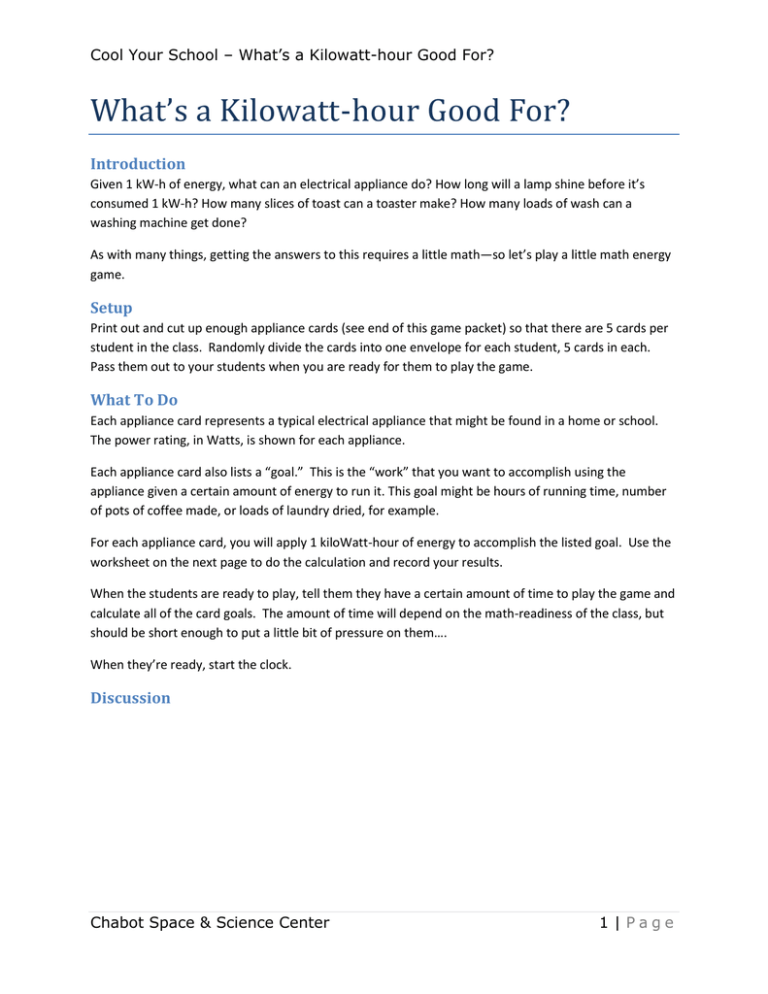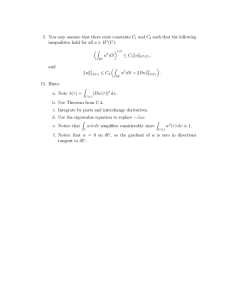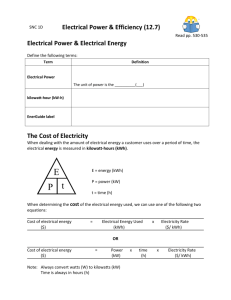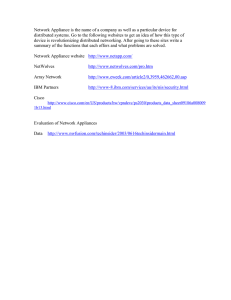What`s a Kilowatt hour Good For?
advertisement

Cool Your School – What’s a Kilowatt-hour Good For? What’s a Kilowatt-hour Good For? Introduction Given 1 kW-h of energy, what can an electrical appliance do? How long will a lamp shine before it’s consumed 1 kW-h? How many slices of toast can a toaster make? How many loads of wash can a washing machine get done? As with many things, getting the answers to this requires a little math—so let’s play a little math energy game. Setup Print out and cut up enough appliance cards (see end of this game packet) so that there are 5 cards per student in the class. Randomly divide the cards into one envelope for each student, 5 cards in each. Pass them out to your students when you are ready for them to play the game. What To Do Each appliance card represents a typical electrical appliance that might be found in a home or school. The power rating, in Watts, is shown for each appliance. Each appliance card also lists a “goal.” This is the “work” that you want to accomplish using the appliance given a certain amount of energy to run it. This goal might be hours of running time, number of pots of coffee made, or loads of laundry dried, for example. For each appliance card, you will apply 1 kiloWatt-hour of energy to accomplish the listed goal. Use the worksheet on the next page to do the calculation and record your results. When the students are ready to play, tell them they have a certain amount of time to play the game and calculate all of the card goals. The amount of time will depend on the math-readiness of the class, but should be short enough to put a little bit of pressure on them…. When they’re ready, start the clock. Discussion Chabot Space & Science Center 1 | Page Cool Your School – What’s a Kilowatt-hour Good For? Energy Worksheet For each Appliance Card, determine the total amount of work the appliance can accomplish with 1 kiloWatt-hour of energy. See example calculations below. Appliance Power (W) Power (kW) Goal Solution Examples: To determine how many hours an appliance will run on 1 kW-h of energy, use the formula Time = Energy / Power, with Energy equal to 1 kW-h. So, given 1 kW-h of energy, a 500 W appliance will run for: 1 kW-h / 0.500 kW = 2 hours To figure out how many times an appliance can do its task on 1 kW-h (make toast, wash a load of laundry, make a milkshake), first use the formula Energy = Power x Time to calculate how many kW-h it consumes to do the task, then divide 1 kW-h by that amount. So for a 500 W appliance that takes 15 minutes to do its task once, the energy it consumes is: 0.500 kW x 0.25 h = 0.125 kW-h And dividing 1 kW-h by that amount: 1 kW-h / 0.125 kW-h = 8 This appliance can do its task 8 times on 1 kW-h of energy. Chabot Space & Science Center 2 | Page Cool Your School – What’s a Kilowatt-hour Good For? LED Night Light Clock Radio LED Lamp 0.5 W 4W 7W Goal: DAYS of continuous use Goal: DAYS of continuous use Goal: HOURS of continuous use Incandescent Lamp CFL Lamp Desktop Computer and LCD Monitor 60 W 18 W 290 W Goal: HOURS of continuous use Goal: HOURS of continuous use Laptop Computer Refrigerator 42” LCD TV 45 W 100 W 160 W Goal: HOURS of continuous use Goal: DAYS of continuous use Goal: HOURS of continuous use Chabot Space & Science Center Goal: HOURS of continuous use 3 | Page Cool Your School – What’s a Kilowatt-hour Good For? Dishwasher (no electric heating or drying) Air Conditioner (small) Toaster 750 W 500 W 200 W Goal: HOURS of continuous use Goal: PIECES OF TOAST (assuming 2 minutes to toast 2 slices) Coffee Maker Electric Heater Electric Oven 900 W 1400 W 2000 W (at 350o F) Goal: POTS OF COFFEE (assuming 5 minutes to make 1 pot) Goal: HOURS of continuous operation Goal: NUMBER OF roasted turkeys (assuming 2 hours to cook a turkey) Electric Clothes Drier 42” Plasma TV XBOX 4400 W 330 W 70 W Goal: NUMBER of laundry loads (assuming 45 minutes to dry one load) Goal: HOURS of continuous operation Goal: HOURS of continuous excitement Goal: NUMBER OF LOADS (assuming 45 minutes per load) Chabot Space & Science Center 4 | Page Cool Your School – What’s a Kilowatt-hour Good For? Classroom Lighting Aquarium (10 gallon) Ceiling Fan 600 W 30 W 50 W Goal: HOURS of continuous lighting Goal: HOURS of continuous use (pump, heater, and lighting included) Goal: HOURS of continuous use Electric Blanket Blow Drier Waffle Iron 200 W 1000 W 1200 W Goal: NIGHTS of use (assuming 8 hours per night) Goal: Number of times drying hair (assuming 3 minutes per drying) Goal: Waffle breakfasts (assuming 20 minutes to cook one breakfast) Electric Iron Microwave Oven Blender 1000 W 1000 W 300 W Goal: Pieces of clothing ironed (assuming 2 minutes per piece) Goal: NUMBER of meals cooked (assuming 15 minutes to heat a meal) Goal: NUMBER of milkshakes (assuming 1 minute per milkshake) Chabot Space & Science Center 5 | Page Cool Your School – What’s a Kilowatt-hour Good For? Solution Key Appliance 42" LCD TV 42" plasma TV Air conditioner Aquarium (10 gallon) Blender Blow drier Ceiling fan CFL lamp Classroom lighting Clock radio Coffee maker Desktop computer and LCD monitor Dishwasher (no heating/drying) Electric blanket Electric clothes drier Electric heater Electric iron Electric oven Incandescent lamp Laptop computer LED lamp LED night light Microwave oven Refrigerator Toaster Waffle iron Xbox W 160 330 500 30 300 1000 50 18 600 4 900 290 200 200 4400 1400 1000 2000 60 45 7 0.5 1000 100 750 1200 70 Chabot Space & Science Center kW Goal Solution 0.16 6.25 Hours 0.33 3.03 Hours 0.5 2.00 Hours 0.03 33.33 Hours 0.3 200.00 Milkshakes (1 minute per) 1 20.00 Dry heads (3 minutes per) 0.05 20.00 Hours 0.018 55.56 Hours 0.6 1.67 Hours 0.004 10.42 Days 0.9 13.33 Pots (1 per 5 minutes) 0.29 3.45 Hours 0.2 6.67 Loads (45 min) 0.2 0.63 Nights (8 hours per night) 4.4 0.30 Loads of laundry (45 min) 1.4 0.71 Hours 1 30.00 Pressed clothing (2 minutes per piece) 2 0.25 Roast turkeys (2 hours per) 0.06 16.67 Hours 0.045 22.22 Hours 0.007 142.86 Hours 0.0005 83.33 Days 1 4.00 Meals (15 minutes per) 0.1 0.42 Days 0.75 80.00 Toast (2 per 2 minutes) 1.2 2.50 Waffle breakfasts (20 minutes per) 0.07 14.29 Hours 6 | Page






